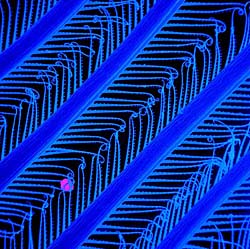
Antarctic Krill Adaptations
Euphausia superba
How are krill adapted to survive
in Antarctica?
A Crustacean and a member of the zooplankton, krill are
super-abundant animals about 4-5cm long that feed on phytoplankton.
Unusually large for zooplankton they are eaten by just about
anything and everything that comes across them
- Anatomical - Structures of the body.
- Behavioural - The manner in which animals
move and act.
- Physiological - The internal functions
of the animal from biochemical, to cellular, tissue, organ
and whole organism level.
These adaptions work in combination.
Krill Anatomical
Adaptations

 Very fine filtering net or "basket" formed by 6-8 pairs
of fore-limbs
Very fine filtering net or "basket" formed by 6-8 pairs
of fore-limbs that can capture phytoplankton down to
1micrometer (1 micrometer = a millionth of a meter), this is
the smallest that phytoplankton there are, no other zooplankton
of this size can do this so it allows krill access to the maximum
amount of food. In the picture to the right a 1micrometer sized
object is seen on a krill filter.
 Other limbs have scraping setae rather than filtering setae,
Other limbs have scraping setae rather than filtering setae,
these are used extensively during the winter months by krill
to scrape phytoplankton off the
underside of
sea ice where there is still enough light penetrating to allow
food to grow.
 Small bioluminescent organs
Small bioluminescent organs are found on several regions
on a krill's body, they have a reflector at the back, a lens
at the front and can be directed using muscles, the function
is not fully known, it may be connected with schooling or mating
.
For this reason krill are sometimes called "light shrimp"
 Complex and highly developed compound eyes,
Complex and highly developed compound eyes, one of
the best visual structures in nature, though why this should
be so in krill is a mystery.
Krill Behavioural Adaptations
 Swarming behaviour similar to schools of small fish
Swarming behaviour similar to schools of small fish
as a defence against predators, such swarms can have up to 10,000
to 30,000 individuals per cubic meter of sea water. This may
be useful against small predators that target individual krill,
but is useless against larger filter feeders such as some seals
and whales.
 In the winter and spring they are found beneath sea ice
In the winter and spring they are found beneath sea ice
where they feed on algae growing on the under side of the ice.
 Rapid backwards escape reaction.
Rapid backwards escape reaction. In common with many
other crustaceans that have a pronounced flattened tail (telson),
krill can flip the telson and shoot backwards several times
in succession to quickly escape from danger
-
this is called "lobstering", you can probably guess why.
 Usually krill stay in deep water during daylight hours and come
to the surface at night,
Usually krill stay in deep water during daylight hours and come
to the surface at night, this helps them to avoid predators.
They have also been shown to spend longer at depth and to go
deeper in the water column when they are near to land and predator
colonies such as penguins and other sea-birds. They will drop
to 80-100m or more (260-330 feet) in the daytime by "parachuting"
down, slowly sinking with outspread limbs and then swim back
up to within 10m (33 feet) of the surface at night to where
the phytoplankton can be found and when predators are relatively
less of a threat.
Krill Physiological Adaptations
 Can withstand long periods of starvation (up to 200 days)
Can withstand long periods of starvation (up to 200 days)
by using their muscle as a reserve, the krill shrink
in the process, this happens over the winter months when the
krill are under seasonal sea ice and there is little or no photosynthesis
 Despite very cold water temperatures, krill are highly active,
Despite very cold water temperatures, krill are highly active,
backwards lobstering takes only 55 milliseconds (0.055s)
from stimulus (optical) to triggering of the escape response
 Female Antarctic krill can lay up to 10,000 eggs at a time,
Female Antarctic krill can lay up to 10,000 eggs at a time,
they can do this several times in a season.
More on Antarctic krill


